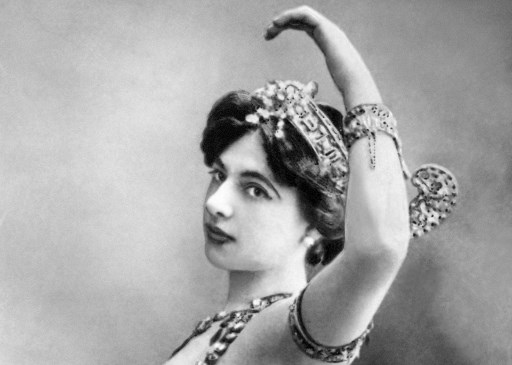

by Charlotte Van Ouwerkerk
Agence France-Presse
LEEUWARDEN, Netherlands (AFP) — She scandalized society by dancing almost naked when women still wore corsets and their dresses long. Yet a century after her death, Mata Hari remains veiled in mystery.
Now a Dutch museum in the Friesian town of her birth is seeking to shed new light on the exotic dancer, bringing together for the first time 150 objects, photos and military archives in the largest-ever exhibition devoted to one of the world’s most famous courtesans and seductresses.
Her story was “a dramatic cocktail of courage and glory, loss and betrayal,” says the museum about the ultimate femme fatale, executed by a French firing squad on charges of being a double agent on October 15, 1917.
Giant black-and-white photos of Mata Hari wearing her barely-there, bejewelled costumes hang on the walls of the Fries Museum in northern Leeuwarden, the town where she was born as Margaretha Zelle in 1876.
Never-before-seen scrapbooks, personal belongings, letters, books and jewellery are on display in “Mata Hari: The Myth and the Maiden” running until April 2.
Shown in darkened rooms where videos play of dancers recreating her sensuous choreography, the exhibition is both intimate and surprising.
There are posters of her appearances in such famous theaters as the Folies Bergere, and in one room by an antique child’s crib visitors learn her two-year-old son, Norman, died of syphilis, likely contracted from his mother.
“It is the story of the life of a very famous person who got a lot of attention during her career, got into a lot of trouble, arrested and accused of being a spy,” said museum curator Hans Groeneweg, who has spent several years amassing the collection.
‘Life ends in tragedy’
Margaretha married young to an army officer 20 years older than her, who was based in the former Dutch East Indies, now Indonesia. They had two children, Norman, and a younger girl, Non.
But in 1903 aged 27, she fled after a nasty divorce to Paris, where, penniless, she became a striptease dancer, taking the name “Mata Hari,” Indonesian for “Eye of the Day.”
The objects on display “trace her path from being a young girl, to her life as a mother,… her exotic career as a courtesan and her journey during the war,” Groeneweg said, adding the aim was to give visitors a more “complete” picture of the real woman.
There is a delicate, crown-shaped gold and pearl brooch, which Mata Hari gave a German officer just before her death, asking him to send it to her daughter, letters after her divorce full of despair, and even her death warrant with the word “Mort” (Deceased) starkly handwritten across it in black ink italics.
“I’m tired of fighting life,” Mata Hari wrote in one letter, appealing that Non, who she’d left behind in The Netherlands, be allowed to join her in Paris.
“Either Nonnie lives with me and I behave like a decent mother, or I’m going to enjoy the beautiful life being offered to me here. I know that life ends in tragedy — but I’m over that,” she wrote presciently.
She was a prolific letter writer and there are missives between her and her husband when she was still deeply in love, as well as her son’s baby album lovingly filled in until his sudden death.
“Instead of dancing to the praise of the powerful and famous, I am here, in a hospital room at the bedside of my dying child,” she wrote.
Later there are postcards from across Europe to her daughter some simply signed “Mama” and French army archives recounting her interrogation and trial kept secret until recently.
“I am desperately worried and I cry all the time,” she wrote in April 1917 to the French judge from her Parisian cell, asking for news of her then Russian lover who had abandoned her.
“You cannot imagine my suffering. Please release me, I cannot cope with it any longer.”
True spy?
Many questions still remain about Mata Hari.
To what extent was she really a spy? Why, after accepting an offer in 1916 from a German diplomat to spy on France if he paid off her debts, did she become a double agent for France? Was she just naive, or desperate, or both?
For Groeneweg there is “always that question: Was she really guilty?”
He believes there is still “not enough proof to say for certain if she was a spy. The French certainly wanted to set an example during a very difficult year in 1917. They used her.”
And despite the exhibition, it seems that in the end, Mata Hari, who reinvented herself as the Javanese princess who rode elephants, took many of her secrets to the grave.
© Agence France-Presse
